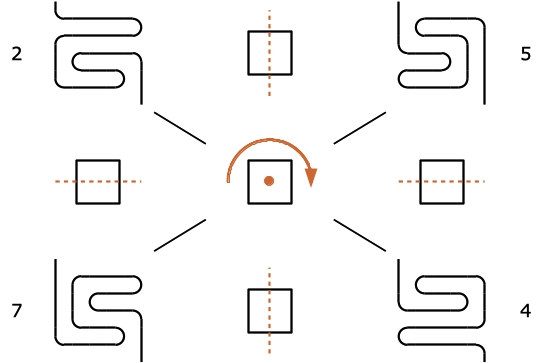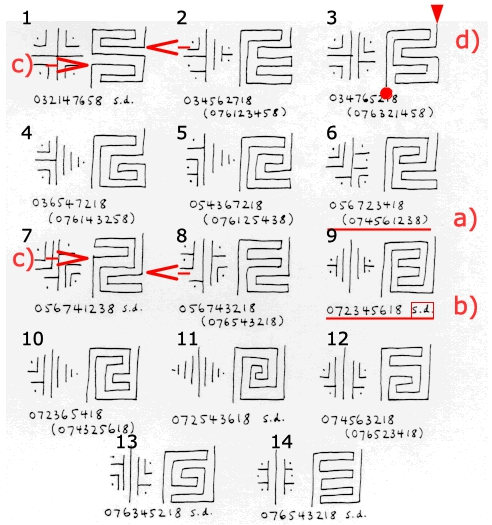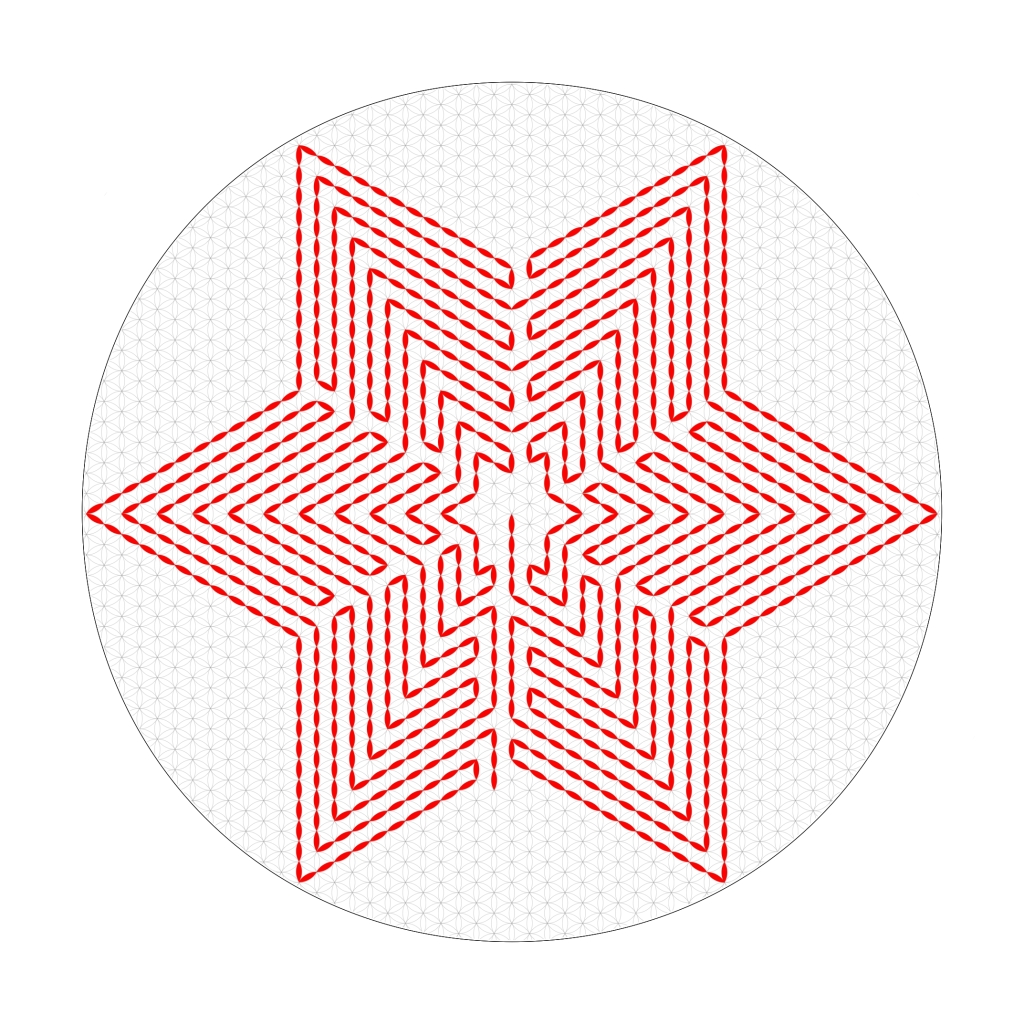Question
As shown by Tony Phillips, there exist 42 different types of alternating labyrinths with 1 axis and 7 circuits (see: related posts 1). However, he has shown only a selection of 14 of these types on his website. A reader has asked us if we could help him find all 42 types. The answer is yes. All basic information we need is already available in various posts of this blog. First I will recapitulate these basics and later derive the 42 types.
First, we need some more precise details of the labyrinths shown on Tony’s website and, second, our knowledge of the groups of relative labyrinths.
As mentioned already earlier (related posts 2), Tony distinguishes between uninteresting, interesting and very interesting labyrinths. Labyrinths in which are attached trivial circuits at the outside or inside (or in greater labyrinths also in between – this, however does not yet apply to labyrinths with 7 circuits) are termed uninteresting. Trivial means attached to one other in the manner of serpentines. Labyrinths in which this is not the case are termed interesting. Particularly, in interesting labyrinths, the pathway does enter the labyrinth on the first circuit and does not reach the center from the innermost circuit either. Very interesting are termed the self-dual among the interesting labyrinths (there are also self-dual uninteresting labyrinths).
On Tony’s website only 14 patterns and seed patterns of interesting and very interesting labyrinths are depicted, as shown in figure 1 (related posts 3). Of dual labyrinths, only one of the patterns and seed patterns is presented, let us call them base labyrinths. However, the sequence of circuits of the dual is also indicated in parentheses (a). For the very interesting self-dual labyrinths „s.d.“ is indicated in parentheses (b). Thus, the following information is available: six self-dual, very interesting labyrinths and 8 interesting labyrinths to which are also indicated the sequences of circuits of another 8 labyrinths dual to them. Therefore we dispose of information about 22 very interesting and interesting labyrinths and we miss information about 20 labyrinths.
Now in addition to dual there are also transpose and complementary labyrinths. Therefore the question is: can we find all missing labyrinths with the transpose and complementary of the 14 available base labyrinths. And the answer is: yes.
For this, let us remember the actions we use to obtain the dual, transpose and complement of a base labyrinth. These are shown in figure 2 (also this figure comes from an earlier post, see: related posts 4). The dual is obtained by rotating the pattern. The transpose is generate by horizonally mirroring, the complement by vertically mirroring of the pattern, whiles in both cases the connections to the exterior and to the center are flipped.
Now, still another distinction is important. The dual of an interesting labyrinth always is also an interesting labyrinth. However, the transpose or the complement of an interesting labyrinth do not necessarily have to be interesting labyrinths too. This is well illustrated in fig. 3 (related posts 5). Labyrinth 5 is an interesting one, similarly the dual of it, labyrinth 7. However, the transpose of labyrinth 5, labyrinth 2, is an uninteresting as the path enters on the first circuit, and the complement of 5, labyrinth 4, is also unintersting, since the path reaches the center from the innermost circuit.
This can be generalized and it means that in a labyrinth with the pathway reaching the center from the first circuit (as in labyrinth 5), the transpose is a labyrinth in which the pathway enters on the first circuit (labyrinth 2), i.e. an uninteresting labyrinth. And also the complement is uninteresting, as the path reaches the center from the innermost circuit (labyrinth 4). And similarly, in an interesting labyrinth with the path entering on the innermost circuit (labyrinth 7), both, the transpose (labyrinth 4) and the complement (labyrinth 2) are uninteresting ones.
With this in mind we now return tot the 14 images of interesting and very interesting labyrinths on Tony’s website. And here we search all patterns with the pathway entering on the innermost or reaching the center from the outermost circuit. Because the transpose and complementary labyrinths of these labyrinths are uninteresting. Therefore I show in fig. 4 once again fig. 1 and simply number the 14 images from 1 to 14. Here, another addition is needed. Tony draws the patterns such that the entrance lies on top right and the center on bottom left (d).
On our search we now find the following labyrinths with their pathway entering on the 7th or reaching the center from the 1st circuit: No. 2, No. 3, No. 4, No. 5, No. 6, No. 8, No. 9, No. 10, No. 11, No. 12, No. 13, No. 14. These are all except No. 1 and No. 7 (c). These, No. 1 and No. 7 are very special labyrinths and have been repeatedly mentioned on this blog already. They are complementary to each other. And they are self-dual and thus also transpose to each other. Because in self-dual labyrinths the complements are the same as the transposes (related posts 0). These are the only two labyrinths in which the base / dual are interesting as well as the transpose / complement. Thus, the transposes and complements of the remaining 12 labyrinths from fig. 4 are still missing.
That is, we search to labyrinths with numbers 2, 3, 4, 5, 6, 8, 10, and 12 two each, to the self-dual labyrinths with numbers 9, 11, 13 und 14 one transpose and complementary labyrinth, thus altogether all 20 missing uninteresting labyrinths.
Thus, we have the following situation: 14 images, among which 6 very interesting self-dual labyrinths as well as 8 labyrinths and their 8 duals, that is 16 interesting labyirnths, together 22 interesting and very interesting labyrinths. Among these are two very interesting transpose / complementary labyrinths. There remain 4 very interesting labyrinths from which 4 uninteresting labyrinths can be derived and 8 interesting labyrinths from which16 uninteresting labyrinths can be derived. Thus we have shown, that all 42 types of alternating labyrinths with 1 axis and 7 circuits can be derived from the 14 labyrinths depicted in Tony’s figure. In the following posts I will show how to do that.
Related Posts:













